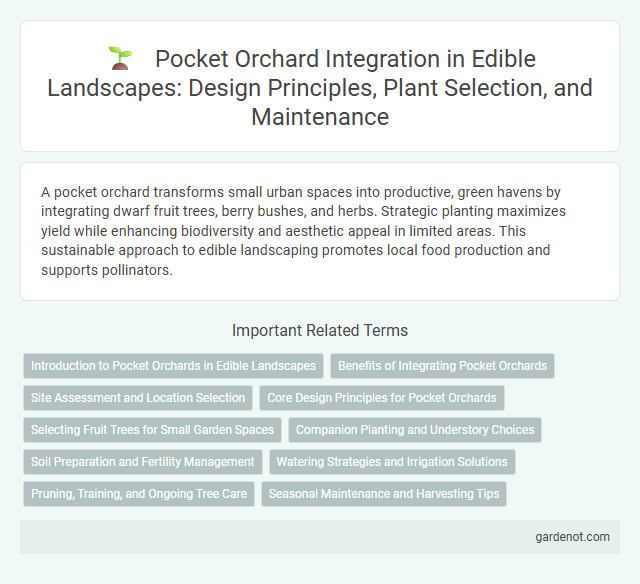A pocket orchard transforms small urban spaces into productive, green havens by integrating dwarf fruit trees, berry bushes, and herbs. Strategic planting maximizes yield while enhancing biodiversity and aesthetic appeal in limited areas. This sustainable approach to edible landscaping promotes local food production and supports pollinators.
Introduction to Pocket Orchards in Edible Landscapes
Pocket orchards transform small urban spaces into productive food gardens by integrating fruit trees with companion plants, maximizing yield in limited areas. These compact, layered ecosystems enhance biodiversity, improve soil health, and provide fresh, homegrown fruits year-round. Strategic planting of dwarf or semi-dwarf fruit trees ensures manageable harvesting and maintenance, ideal for sustainable edible landscapes.
Benefits of Integrating Pocket Orchards
Integrating pocket orchards into urban and suburban landscapes enhances local biodiversity by providing habitat for pollinators and wildlife. These compact fruit tree clusters improve food security by offering fresh, nutritious produce within walking distance. Pocket orchards also contribute to sustainable water management and reduce carbon footprints through carbon sequestration and decreased food transportation.
Site Assessment and Location Selection
Pocket orchard site assessment requires analyzing soil quality, sunlight exposure, and water availability to ensure optimal fruit tree growth. Selecting a location with well-drained soil, at least six hours of direct sunlight daily, and proximity to water sources enhances orchard productivity and health. Considering microclimates and potential pest exposure further refines location suitability for sustainable orchard management.
Core Design Principles for Pocket Orchards
Pocket orchards prioritize high-density tree planting to maximize fruit yield in limited spaces, emphasizing dwarf or semi-dwarf rootstocks for manageable growth. Companion planting and integrated pest management enhance biodiversity and reduce the need for chemical inputs, supporting sustainable cultivation. Soil health is maintained through organic mulching and regular nutrient cycling to ensure long-term productivity and resilience.
Selecting Fruit Trees for Small Garden Spaces
Selecting fruit trees for small garden spaces involves prioritizing dwarf or semi-dwarf varieties that fit compact areas without sacrificing yield. Consider trees like columnar apples, dwarf pears, and miniature citrus species, which offer high productivity and ease of maintenance. Focus on rootstock compatibility and pollination requirements to optimize growth and fruit production in pocket orchards.
Companion Planting and Understory Choices
A pocket orchard integrates companion planting by pairing fruit trees with complementary understory plants that enhance growth, deter pests, and improve soil health. Common understory choices include nitrogen-fixing legumes, aromatic herbs like thyme or rosemary to repel insects, and ground covers such as strawberries to conserve moisture and reduce weeds. This strategic layering creates a synergistic ecosystem, promoting biodiversity and maximizing edible yield within limited urban or backyard spaces.
Soil Preparation and Fertility Management
Pocket orchards thrive with well-prepared soil enriched by organic compost and balanced nutrients to support fruit tree growth. Incorporating cover crops and natural amendments like well-rotted manure enhances soil fertility and microbial activity, fostering robust root systems. Regular soil testing informs targeted fertilization, ensuring optimal nutrient availability for sustainable orchard productivity.
Watering Strategies and Irrigation Solutions
Pocket orchards benefit from drip irrigation systems that deliver water directly to the root zone, minimizing evaporation and runoff while promoting healthy tree growth. Employing mulching techniques around the base retains soil moisture and reduces the frequency of watering sessions. Smart irrigation controllers with soil moisture sensors optimize water usage by adjusting schedules based on real-time environmental data, ensuring efficient hydration tailored to each fruit tree species.
Pruning, Training, and Ongoing Tree Care
Pruning in a pocket orchard is essential to maintain tree health and optimize fruit production by removing dead or overcrowded branches, improving air circulation, and increasing sunlight penetration. Training young trees through techniques such as espalier or central leader systems shapes growth, enhances structural stability, and maximizes available space in small gardens. Ongoing tree care includes monitoring for pests and diseases, regular watering, mulching to conserve moisture, and seasonal fertilization to support vigorous growth and high-quality fruit yields.
Seasonal Maintenance and Harvesting Tips
Regular pruning of pocket orchard trees during late winter promotes healthy growth and maximizes fruit production. Monitor for pests and diseases throughout the spring and summer to protect the yield and ensure high-quality harvests. Harvest fruits at peak ripeness, typically in late summer or early fall, for optimal flavor and nutritional value.
Pocket orchard Infographic

 gardenot.com
gardenot.com